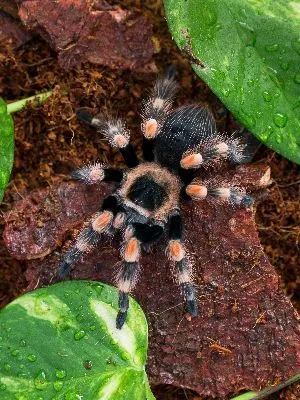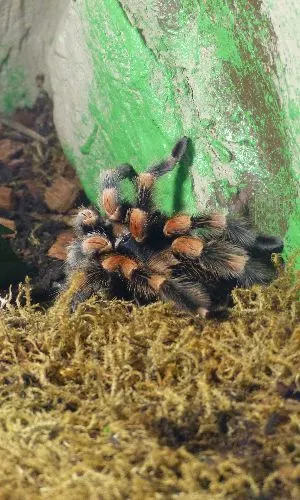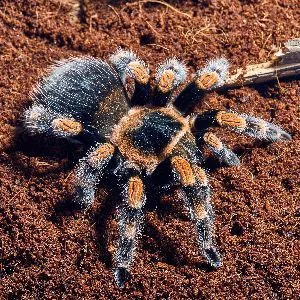The Mexican Red-knee tarantula is a popular beginner tarantula due to its long lifespan and easy care. Enthusiasts and keepers also adore these spiders due to their unique look.
These tarantulas do not require much space or care and will be a beautiful addition to your home. They are also docile creatures that are not easily bothered and will remain rather calm in many situations.
If you are thinking about keeping a Mexican Red-knee, you have come to the right place. Read on to learn more about how to care for this interesting-looking tarantula.
Table of Contents
Bioactive Mexican Red Knee Setup Product List
- Enclosure: Exo Terra Glass terrarium kit
- Soil: Zoo Med Reptisoil
- Moss: Zoo Med terrarium moss
- Hide: Zoo Med cork hide
- Leaf Litter: Sungrow leaf litter
- Hygrometer: Zoomed hygrometer
- Cleaners: Springtails & Isopods
- Water Dish: Zoo Med small water dish
Mexican Red-knee tarantula facts
- Experience Level: Beginner
- Family: Theraphosidae
- Scientific Name: Brachypelma smithi
- Adult Size: 7 to 8 inches
- Diet: Carnivore
- Lifespan: Females: 25 to 30 years; Males: 10 years or less
- Average Price Range: $40 to $300 per spider
- Where to buy: backwaterreptiles.com, undergroundreptiles.com, exoticpetsandmore.net, microwilderness.com, bigappleherp.com

These guys can live for over 20 years, particularly if they’re female.
In the wild, they live in burrows where they can hide from any predators and entrap their prey.
However long your particular Mexican Red-knee is, they can stretch their legs out almost twice that length.
Appearance

They have a black, hairy body with patches of orange or blood orange on their “knees” or the joints in their legs, thus giving them their name. They have eight legs, as all arachnids do and males will have a smaller body than females.
Natural Habitat
Mexican Red-knees come from tropical deciduous forests in, you guessed it, Mexico, of course!
They can be spotted in deserts, thorn forests, tropical rainforests, coastal regions, and scrublands. They tend to gravitate toward rugged land that has bushes, cacti, and large logs.
This means keeping one would require consistent temperature and humidity maintenance that mimic that of their natural habitat.
Mimicking these numbers in an enclosure can totally be done and isn’t hard to do if you put in the effort for your pet.
Diet
In the wild, these tarantulas feed on a diet mostly consisting of insects. They will, however, sometimes go after reptiles, frogs, smaller mammals like baby mice, and even birds as well.
These tarantulas burrow, hiding away from predators and waiting to stalk their prey. When they see prey come near their burrowing hole, they will attack out of hiding and eat them live.
Lifespan

Female Mexican Red-knee tarantulas can live anywhere from 25 to 30 years, whereas males will not usually exceed a lifespan of 10 years.
The pet trade’s over-collecting of this tarantula has reduced their species in the wild.
These are slow-growing spiders that will molt every 2 weeks their first 4 months of life, and then less frequently as they mature into adulthood, which generally takes a year.
Breeding
The Mexican Red-knee female will have an average of 40 babies and they usually have them between May and August.
The male tarantula weaves a pre-packaged silk ball with their deposited sperm, saves it in their pedipalps, finds a female mate, and then will attempt to deposit it into the female’s spermathecae, where she will store it.
However, this process may or may not happen if the female does not deem the male worthy, to which she will then cannibalize him. If she finds a mate or worthy suiter, she will allow him to deposit his sperm web ball into her spermathecae, and copulation will commence.
If the male is successful, he has a few minutes to run away since female tarantulas will be entranced with chemicals right after fertilization. If he is unable to escape her during that short time, he might be her dinner.
Tarantulas mating is more like an aggressive transaction rather than a sexual experience and it is life or death for the male.
She will then guard her protected clutch of eggs for a span of about 6 to 8 weeks, which is the average incubation period until they hatch.
Check out this keeper’s breeding process of their Mexican Red-Knees here:
If you are going to attempt to breed your spiders, you need to be fast and ready to remove the male after he fertilizes her.
Legality
In general, tarantulas are legal to keep in most states, although there may be local laws that restrict captivity, breeding, and such. Check out your local laws to find out what is and is not allowed in your state or city.
You can find them at pet stores easily, but we recommend you also try to look for a rescue group or at least make sure you buy from a licensed, reputable breeder.
Mexican Red-Knee Tarantula Care Sheet

Enclosure
Housing a Mexican Red-Knee Tarantula will require a 20-gallon tank.
A good rule of thumb to follow when choosing a suitable tank size is that the width should be about two to three times wider than your spider’s leg span.
This also applies to the height of your spider’s tank, but since they are ground-dwellers who like to burrow, you won’t have to worry about them climbing out. It is always smart to find a tank with a sturdy top and good ventilation though.
Keep in mind that they need consistent temperatures and humidity so find a tank that can take these temperatures and percentages comfortably.
Substrate

You want to allow them to naturally burrow, as they do in nature. They will need at least 2 to 3 inches of substrate and maybe some burrowing accessories that will feel natural to them.
If you want to allow for natural burrowing, make sure it is at least 4 inches deep and that any accessories in the tank won’t disturb them.
Bedding or substrate should be a loosely packed mix of soil, vermiculite, and peat moss. This will allow natural burrowing and will make for a softer landing in case they fall.
They are quite squishy and even a short fall can be fatal due to their weak exoskeleton so soft, moist bedding is the best option for them.
Accessories
Because they burrow in nature, you can include a cork bark slab and insert it horizontally into a substrate that is about 2 to 3 inches deep.
Other than providing for their burrowing needs, they do not require much in terms of tank accessories.
Temperature
The Mexican Red-knee tarantula comes from hot climates of around 75 to 80 degrees Fahrenheit. It is truly important that you maintain consistent humidity and temperature in your spider’s terrarium in order to keep them healthy.
We recommend that you keep their tank at around 75 to 80 degrees Fahrenheit by using a heating pad under a portion of your spider’s tank. This way, your spider has the option of a cooler side and warmer side for all their temperature needs.
Humidity
These spiders need a high-humidity environment since this is how their natural habitat is. They come from a climate with humidity levels of around 65% to 75%.
They should be perfectly comfortable around these levels. You must keep an eye on the humidity levels of your tank and must not allow it to drop below 55%, if possible.
Lighting
These nocturnal arachnids hunt at night and sleep during the day.
While they do not require lighting since it is not essential to their survival, you can angle a desk lamp down into their enclosure to look at them, but what matters more is the temperatures.
Don’t worry about lighting but do keep track and monitor their tank temperatures since it is more essential to their well-being.
Feeding
In captivity, Mexican Red-knees feed on live crickets, locusts, and cockroaches. You may want to think about raising a colony beside your spider to always keep fresh food around for it.
You can feed them once or twice a week. They may take a break from feeding if they are molting, so keep an eye out for that.
Temperament
This species of tarantula is very docile, calm, and hard to make defensive.
Even if they do feel threatened by you, they will first eject urticating hairs from their abdomen and legs, then flee or jump before even trying to bite you.
Generally, they aren’t defensive around humans and are not hard to handle at all.
Handling

In terms of handling, Mexican red-knee tarantulas are quite delicate due to their eggshell-like exoskeleton. A short fall onto a hard floor could result in death so make sure you are handling them close to the ground, which is hopefully carpeted.
They are the calmest spider when it comes to handling and is slow-moving, which is a plus. They can be handled regularly without any issues of causing stress to it.
However, keep in mind that they have squishy bodies which can be crushed by even a small fall, so keep that in mind when you are spending time with your pet spider and stay at a safe distance to the ground.
It is best to handle them while sitting on a carpeted floor.
Check out this YouTuber’s informative video on handling their very own Mexican Red-knee Tarantula:
Are red knee tarantulas easy to care for?
Yes, Mexican red-knee tarantulas are relatively easy to care for. With proper habitat setup, consistent feeding, and routine maintenance, these tarantulas can thrive. Their care requirements are straightforward and, once established, only need regular check-ups to ensure they remain healthy.
Are Mexican red-knee tarantulas good for beginners?
Absolutely! Mexican red-knee tarantulas are one of the most recommended species for beginners due to their calm disposition and straightforward care requirements. They are less likely to be defensive or aggressive compared to some other tarantula species, and they showcase stunning colors that make them a favorite among hobbyists.
Do Mexican red-knee tarantulas need heat?
Mexican red-knee tarantulas thrive best in temperatures ranging from 70-85°F (21-29°C). While they can tolerate slight fluctuations outside of this range, prolonged exposure to cold temperatures can be detrimental.
If your home is cooler than the recommended range, you may want to use a heat mat or a ceramic heat emitter to gently raise the temperature. However, always ensure that the heat source doesn’t overheat the enclosure or create hotspots. A thermometer can be useful to monitor the temperature inside the enclosure.
How much space does a Mexican red knee tarantula need?
For an adult Mexican red-knee tarantula, an enclosure of around 5-10 gallons is typically sufficient. The width of the enclosure should be at least three times the leg span of the tarantula, and the depth should be at least two times its leg span to allow for burrowing. A secure lid is essential to prevent escapes.
Remember, these tarantulas are more terrestrial, meaning they spend most of their time on the ground, so providing horizontal space is more crucial than vertical height. Ensure there’s enough substrate for the tarantula to burrow if it wishes and add hides and decorations to make the spider feel secure.
Conclusion
The Mexican Red-knee tarantula is a beautiful spider and a good choice for those who find tarantulas cute since they can be handled without any issues of stress.
As long as you are taking proper care of them and are educating yourself on how to provide for them completely, you should have no issues with this tarantula.
They may not be the most cuddly pets, but this species is a lot more comfortable when it comes to handling due to its calm demeanor.
We hope you learned something new that will help you bond with your Mexican Red-knee tarantula even more so than before!
More tarantulas stuff
